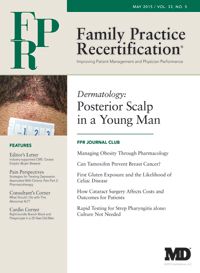Publication
Article
Family Practice Recertification
Posterior Scalp Papules in a Young Man
Author(s):
This 25-year-old African-American man has had this papular rash for the last 2 years following a short haircut. Initially he had pustules, itching and inflammation but currently only has itching papules that are slowly enlarging. Triamcinolone 0.1% ointment has helped the itching. Past history and remainder of physical examination is noncontributory.
This 25-year-old African-American man has had this papular rash for the last 2 years following a short haircut. Initially he had pustules, itching and inflammation but currently only has itching papules that are slowly enlarging. Triamcinolone 0.1% ointment has helped the itching. Past history and remainder of physical examination is noncontributory.
What is your diagnosis?
a) Acne keloidalis nuchae
b) Kerion
c) Lupus
d) Folliculitis
e) Pseudofolliculitis barbi
Diagnosis
Acne keloidalis nuchae occurs predominantly in people of African descent with curly hair. It is more common in men than women and often due to cutting the hair very short as in this young man. When curly hair is cut close to the skin, the tip can grow back into the skin leading to inflammation, localized papules and even larger keloid formation. Avoiding cutting the hair short or using razors on the posterior neck can help prevent this condition.
The early cases can be treated with topical steroids and retinoids along with avoiding clothing or athletic equipment that rubs against the area. Over time, with enlargement of the lesions, keloid formation and scarring alopecia can occur. Injected corticosteroids may be helpful, and in severe cases resection of the area with primary closure or healing by secondary intent may be required1.
Kerion is a fungal infection of the hair and scalp resulting in a painful often fluctuant mass that can cause associated alopecia. This patient had no purulence and the follicles showed crowding rather than a circumscribed loss of hair. In addition, kerion usually occurs in children rather than adults. It requires treatment with systemic antifungal agents and corticosteroids to reduce the inflammation and scarring3.
Discoid lupus erythematosus, as the name implies, causes red round lesions which are most commonly on the scalp. It has associated scale and can lead to localized alopecia. Systemic lupus erythematosus can cause diffuse scarring with associated alopecia. Both of these are in contrast to our patient’s localized papular eruption with crowding of follicles.3
Folliculitis presents as localized erythema or purulence at the hair follicle. While this patient may have had folliculitis at initial onset of symptoms it has progressed to the more chronic process of acne keloidalis nuchae.
Pseudofolliculitis barbi is the same process as acne keloidalis nuchae but is the term used when it occurs in the beard area rather than the posterior scalp/neck. These conditions can occur simultaneously in the same patient. Avoiding shaving altogether or shaving with the direction of the hair growth and using depilatory creams may reduce the irritation and “razor bumps."1
About the Author
Daniel Stulberg, MD, is a Professor of Family and Community Medicine at the University of New Mexico. After completing his training at the University of Michigan, he worked in private practice in rural Arizona before moving into full-time teaching. Stulberg has published multiple articles and presented at many national conferences regarding skincare and treatment. He continues to practice the full spectrum of family medicine with an emphasis on dermatology and procedures.
presentation and management. Am J Clin Dermatol. 2014 Aug;15(4):307-21.
2008 Jul-Aug;21(4):245-8.






